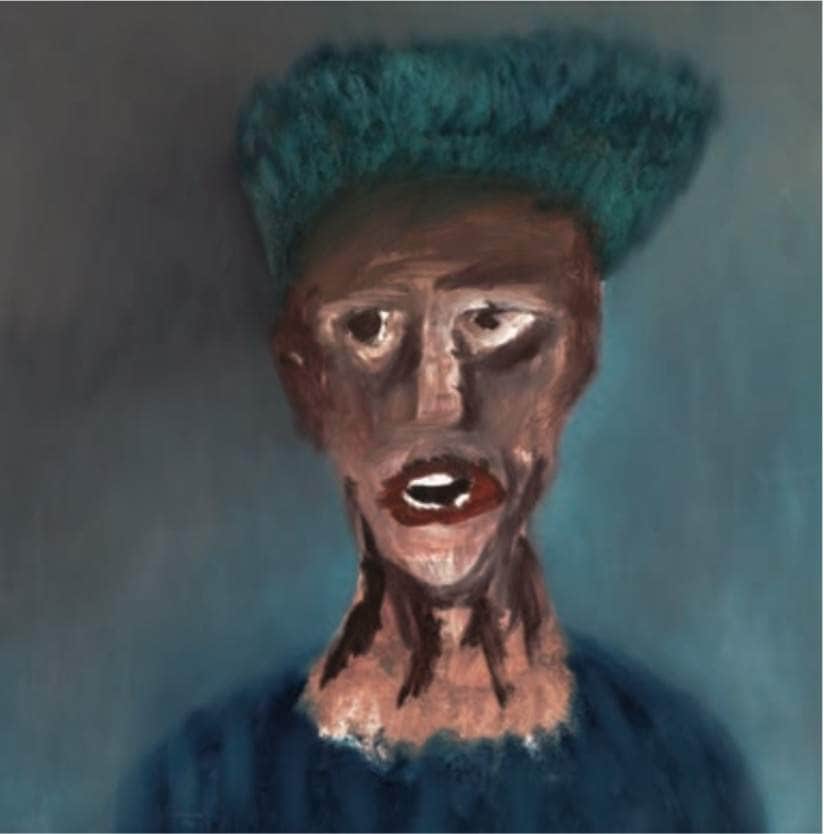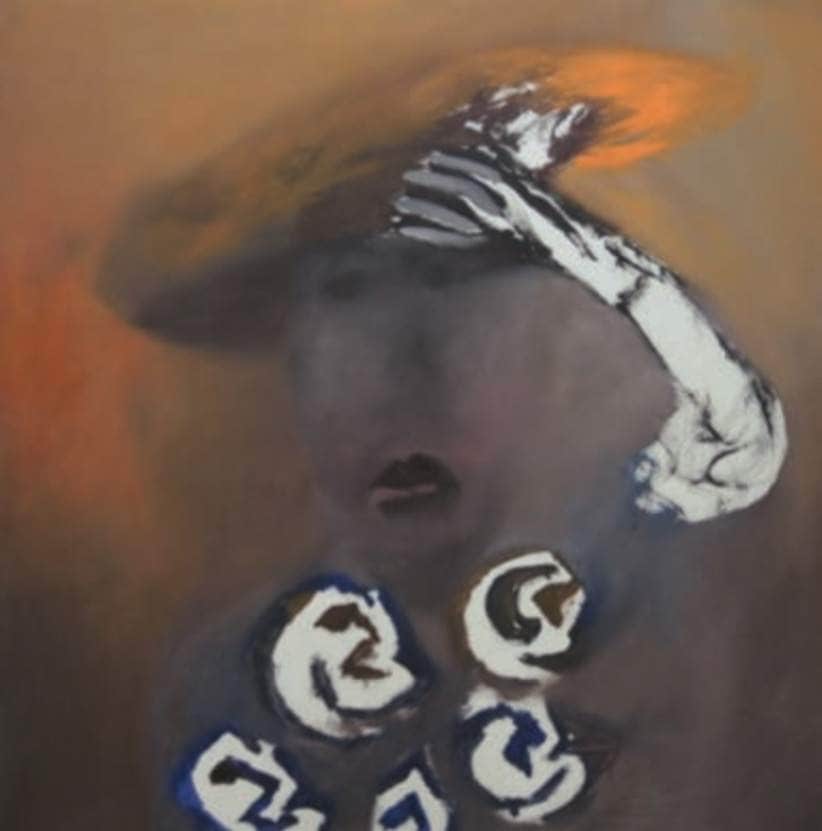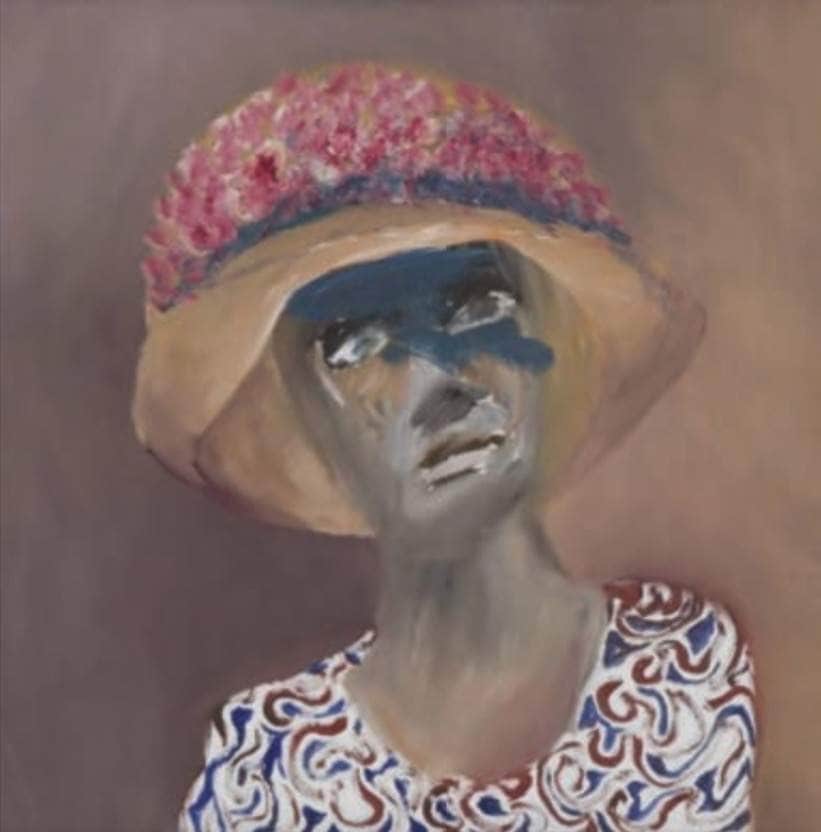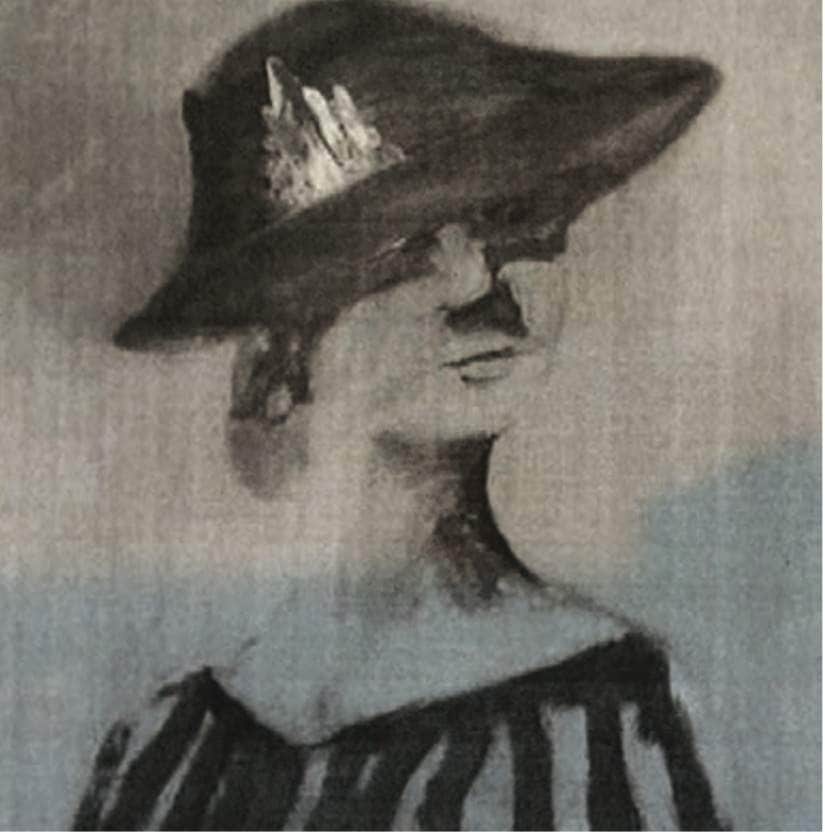In 1964 Sidney Nolan painted at least 59 large portrait style works, known generically as the Adelaide Ladies. In 2016, friend and fellow Nolan enthusiast Andrew Turley wrote and published A guide to the ladies: 59 works by Sidney Nolan – April 1964 to June 1964 which documents his research into this little known area of Nolan’s oeuvre.
The Foreword, Introduction and Epilogue to Andrew’s book can be read here. This post reproduces the chapter that examines in detail the first seventeen of the 59 ladies, painted between 27 April and 12 May 1964.
FROM ENGLISH SOIL AND ADELAIDE
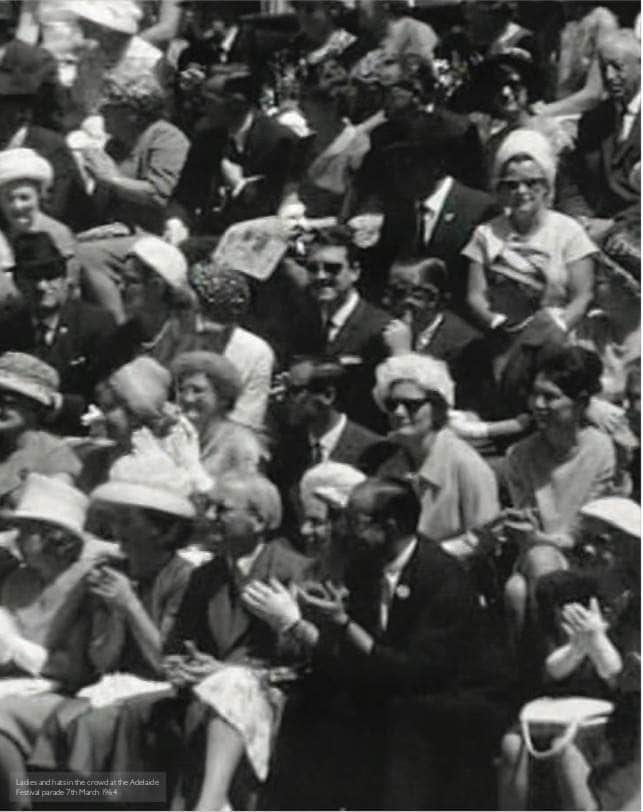
Ladies and hats in the crowd at the Adelaide
Festival parade 7th March 1964
“This reviewer remembers seeing together with the artist, the crowds of ladies, young and old, all similarly wearing flower-festooned hats as they paraded at the garden party at the last Adelaide Festival of the Arts”.
Art Reviewer SMH, May 19651
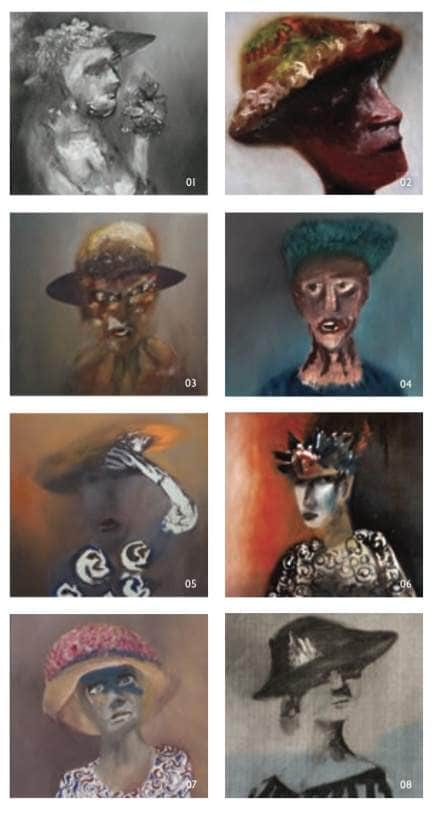
Hats were the trigger for Sidney’s Adelaide Ladies. The first half of this group clearly owes its existence to the accessory, a peculiar collision of images imprinted from the Adelaide Festival, the writings of Nobel Prize-winning author Patrick White and the shadow-lines of Rembrandt.

In his youth Sidney did work for Fayrefield Hat Factory in Melbourne, and assisted commercial artists on a variety of projects. Many featured headshots of models wearing Fayrefield hats set against painted backgrounds. These experiences are immediately recognisable from ‘Woman bouquet’ (no.1) through to ‘Portrait of a lady’ (no.8).
You may also recognise, in this first group, the sprawling images conjured up by Patrick White’s bitter women in ‘Riders in the Chariot’.
Patrick was quick to lay claim to Sidney’s Ladies origins, enthusing in a letter on the 12th June 1964, the day after the last painting was dated, “I hear quite often from the Nolans who are returning (to Australia) next year as a result of an idea I gave him for a new series of paintings”2
The women of Sarsaparilla were renowned for their predisposition to excessive millinery. But the belief that the Ladies of Sidney’s series are always wearing a hat is not quite true.
From the 29th of April to the 6th of May, hats flicker frequently, like a faulty neon sign, then suddenly burn bright again in the group that follows on May12th.
I have deemed April 27th 1964 as my ‘official’ start of the series – after Sidney’s birthday on the 22nd, ANZAC day on the 25th and his 26th diary entry. Although there are earlier references to the Adelaide Ladies, it was from April 27th that they begin to promenade proudly from the studio, continuing on an almost daily basis for 46 days.
Sidney first found his mood in ‘Head bouquet’ (no. 1) and ‘Head in profile’ (no. 2) with their sideways looks and rich colours. He followed with a lightning strike of bitterness in ‘Woman cat eyes’ (no. 3) and a more tempered sourness in the narrow eyes and wrinkled skin of ‘Suburb’ (no. 4). Mid-century ‘Englishness’ arrived in ‘Woman hand on hat’ (no. 5) and continued through to ‘Portrait of a lady’ (no. 8) with embellished hats, shadowed eyes locked in disapproving gazes and crimped lips. In ‘Woman with spiked hat’ (no. 6), ‘Woman pink flower hat’ (no. 7) and ‘Portrait of a lady’ (no. 8) it is also easy to see Rembrandt’s influence in the shadows cast across the eyes, a gentle precursor to some of Sidney’s later hat-wearing Gallipoli heads.
Sidney’s opening salvo of flowers, spikes, felt and feathers faithfully reflects his belief that the middle class English culture he saw at the Adelaide Festival was still firmly rooted in Australian consciousness – “that is their culture and that is what they have inherited”, he said “they’ve got Keats and Shakespeare; that’s what they’ve been taught at school and that’s what they’ve got to deal with as much as possible…they tend to come back to what they know, what came out of the ships”.3
Then from ‘Girl and the moon’ (no. 9) on April 29th through to ‘Head untitled’ (no. 14) on May 5th, the characters stumble, temporarily losing their hats and their geography, in the same way Patrick White stumbled with the geography of the town of Sarsaparilla from “Riders in the Chariot”. Patrick said he hadn’t located the novel in rural Australia “Nor can one say it takes place in a suburban town. Rather it converges on Sydney and the suburban outskirts from England, the north of Germany and somewhere in the north of this state”.4
When, on May 6th, the Ladies don headwear once again and dress in richer, deeper colours, they shift from aloof England to the stoic look of the “Fatherland” and the two works that follow, ‘Woman red hat’ (no. 15) and ‘Woman white flowers’ (no. 16) were a likely commentary on the identity of Indigenous Australians.
The last painting from this group is titled ‘Woman laughing’ (no. 17). She is the prelude to the second major group in the series and heralds an important change in Sidney’s style. Dated May 12th, she belongs to the same date as all six works categorised in Group 2, but she follows firmly in the style of her Group 1 predecessors. Her orange and green hat, dissolving face and red lips open a window to the make-up of distinctive faces on dark backgrounds and hats in irregular patches of light that follow the same day.
There were certain days, Sidney said, “if the moment is right you start to work away quite consciously and the paint itself, which is just an intractable material, actually begins to spread itself into forms”.5
It appears that after a halting start, May 12th and the second group turned out to be one of those days for Sidney.
“Nolan often seemed to lose himself…drifting into a sort of weightless trance while the images continued to build to their conclusion”.
Brian Adams6
01 Head (bouquet)
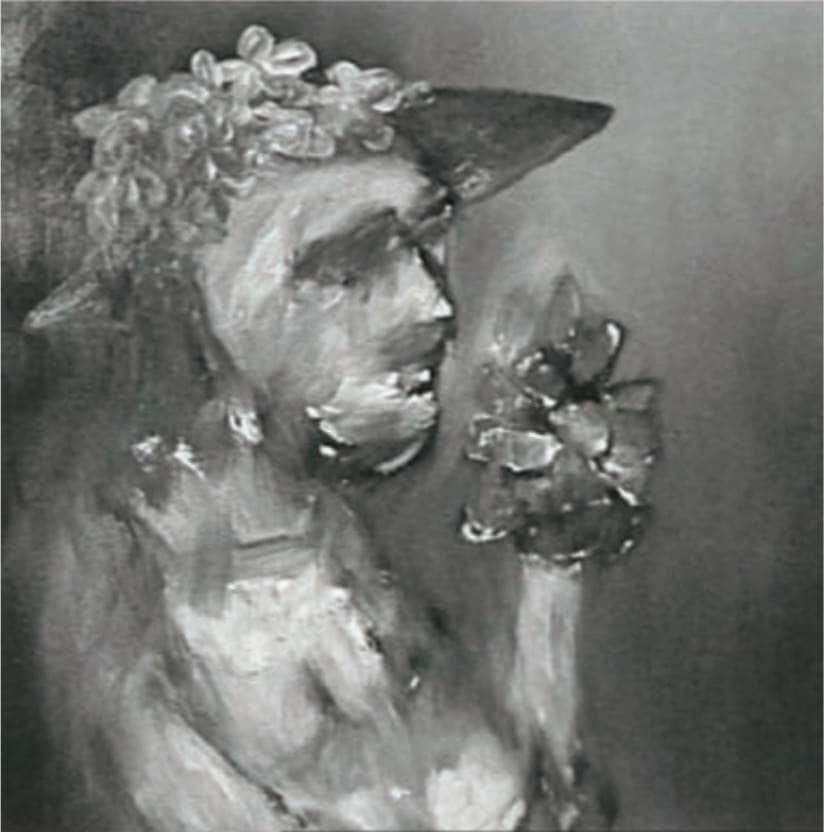
121 x 121cm, oil on hardboard.
Exhibited
- ‘Nolan’, David Jones’ Art Gallery, Sydney, May 1965 (one of nos.19-22, all 121 x 121cm and all entitled ‘Head’)
- Possibly ‘Sidney Nolan Recent Paintings’, Albert Hall, Canberra, 26 Aug – 8 Sep 1965, nos.25-39, titled “Heads, Faces and Hats”1964
Literature
- ‘Exhibition by Nolan’, Sydney Morning Herald, 6th May 1965, p.9 (illus) Film & Television
- ABC news segment Ref 438389 ‘Painter Nolan attends opening of exhibition’, May 1965
Provenance
- Location unknown
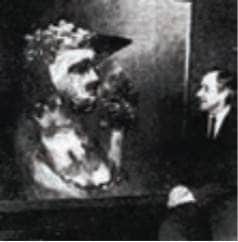
Sidney and one of his ladies. Taken at the David Jones Gallery and published by the Sydney Morning Herald, 5th May 1965
02 Head (in profile)
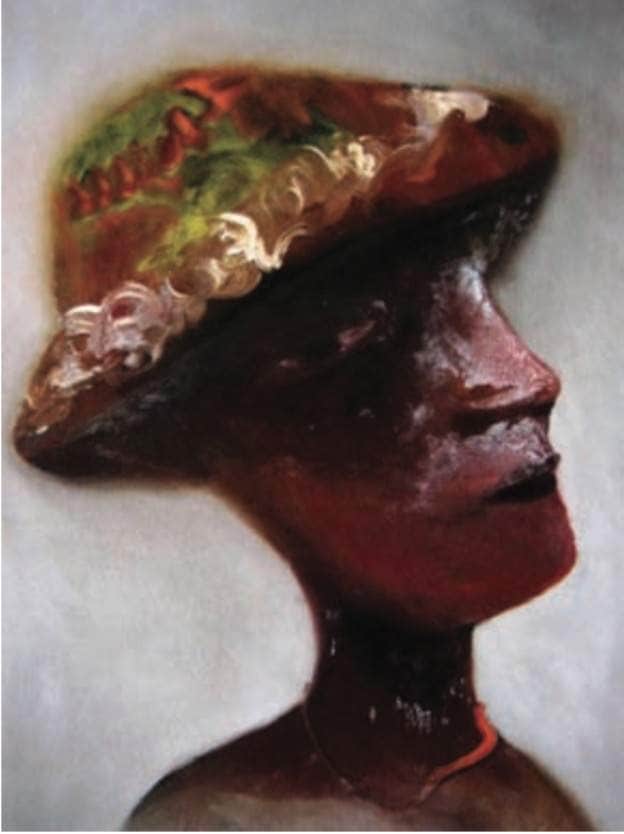
121 x 91cm, oil on board, signed with initial ‘N’, lower right, signed and dated ‘Nolan 27.4.64’ on the reverse.
Exhibited
- Possibly ‘Nolan’, David Jones’ Art Gallery, Sydney, May1965 (one of nos. 23 or 24 both 121 x 91cm and both entitled ‘Head’)
- Possibly ‘Sidney Nolan Recent Paintings’, Albert Hall, Canberra, 26 Aug – 8 Sep 1965, nos. 25-39, titled “Heads, Faces and Hats” 1964 – two paintings 121 x 91cm
Provenance
- Christie’s, Australian and European Paintings, Drawings and Prints, Part I and II, Melbourne, 29/04/1997, Lot 10
- Current location unknown
03 Woman (cat eyes)
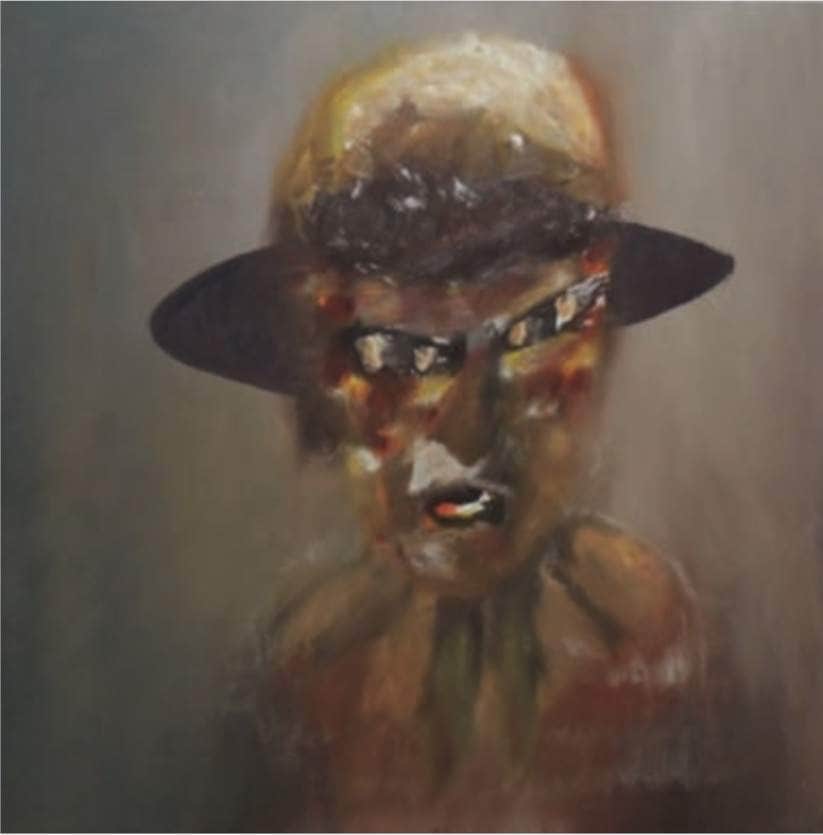
121 x 121cm, oil on board, signed and dated ‘Nolan 27.4.64’ on the reverse.
Provenance
- Sidney Nolan Estate
- Private collection
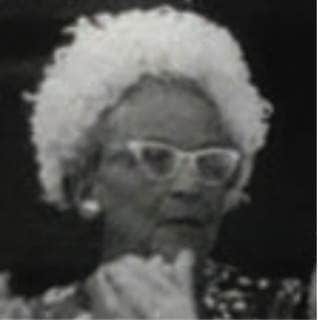
Hat and “cats-eyes”. A dignitary from the 1964 Adelaide Festival opening ceremony wearing winged “cat’s-eye glasses”
04 Suburb
121 x 121cm, oil on board, signed and dated ‘27-4-64’ lower left, signed, dated and inscribed on the reverse.
Exhibited
- Sidney Nolan’, Marlborough-Gerson Gallery, New York, Jan 1965, cat.34
- Most probably ‘Sidney Nolan Recent Paintings’, Albert Hall Canberra, 26 Aug – 8 Sep 1965, nos.25-39, titled “Heads, Faces and Hats”1964
- ‘Sidney Nolan retrospective exhibition. Paintings from1937 to1967’, Art Gallery of New South Wales (13 Sep 1967 – 29 Oct 1967), Sydney. National Gallery of Victoria (22 Nov 1967–17 Dec 1967), Melbourne. Western Australian Art Gallery (9 Jan 1968 – 4 Feb 1968), Perth. cat.122 “Suburb”
- Institute of Contemporary Arts, London, Poetry International Festival, 19-24 Jun 1972
Literature
- ‘Sidney Nolan’, Marlborough-Gerson Gallery, New York, Jan 1965, illus (col)
- Patrick White, ‘The Burnt Ones’, First Edition, Eyre and Spottiswoode, England, 1964 illus (col) cover
- Bulletin Magazine,1967, illus (col)
- Rodney James, Sidney Nolan, Antarctic Journey, MPRG, 2005 p.17 illus (col)
- Andrew Turley, ‘Painted Ladies’, Portrait, Magazine of the NPGA, Spring (Sep) 2015, p.64 illus (col)
Provenance
- Cynthia Nolan Collection to1976
- Charles Osborne Collection London to1993
- Sotheby’s, Fine Australian Paintings, Sydney, 29/11/1993, Lot 183
- Mossgreen Auctions, Important Australian & International Art, Melbourne, 28/10/2014, Lot 80
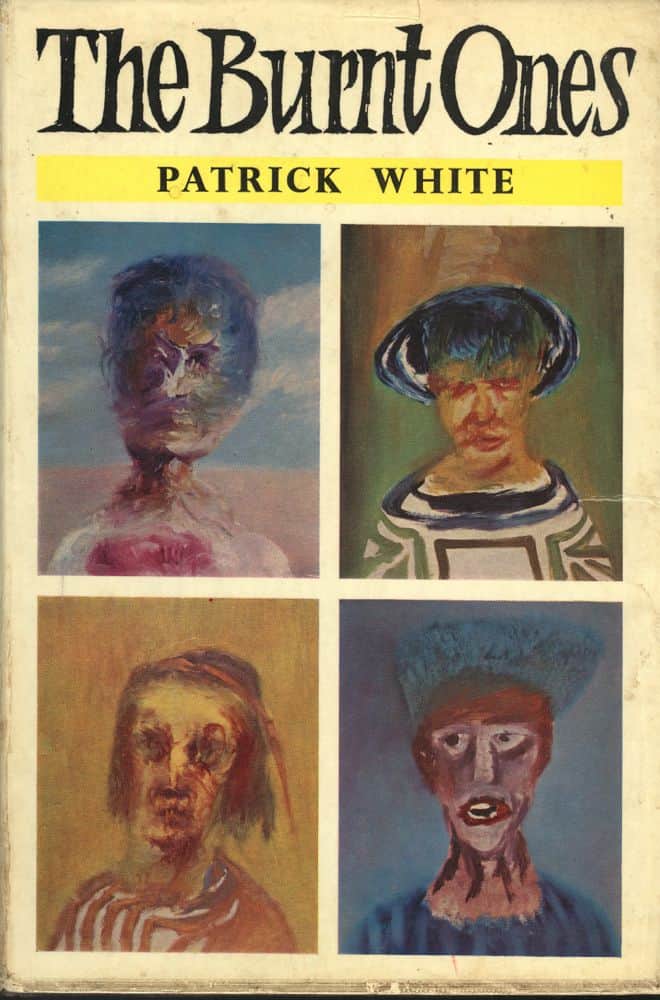
Patrick White, “The Burnt Ones”, Eyre & Spottiswoode, London, 1964. ‘Suburb’ (lower right) is one of four Ladies gracing the publication.
05 Woman (hand on hat)
121 x 121cm, oil on board, signed and dated lower left, signed, dated and titled on reverse ‘Woman 1964 / 28.4.64 / Nolan / S759 / JH’.
Provenance
- Sidney Nolan Estate
- Private collection
A number inscribed on the reverse of this painting ‘S759’ is also inscribed on the reverse of ‘Woman laughing’ (no.17) and ‘Country Woman’ (no.43)
The pattern seeded in the blouse of ‘Woman hand on hat’ (right) is a perfect example of one of Sidney’s treatments twisting from board-to-board. In the next work of the same day – ‘Woman with spiked hat’ (no.6) – it is again recognisable, but now as tight scratchy curls. And the following day in ‘Woman pink flower hat’ (no.7) it has matured into a complex and colourful arrangement with the original geometry from April 28th intact.

Evolving patterns. Detail from the next painting in series ‘Woman with spiked hat’ (no.6). 28th April 1964
06 Woman (with spiked hat)
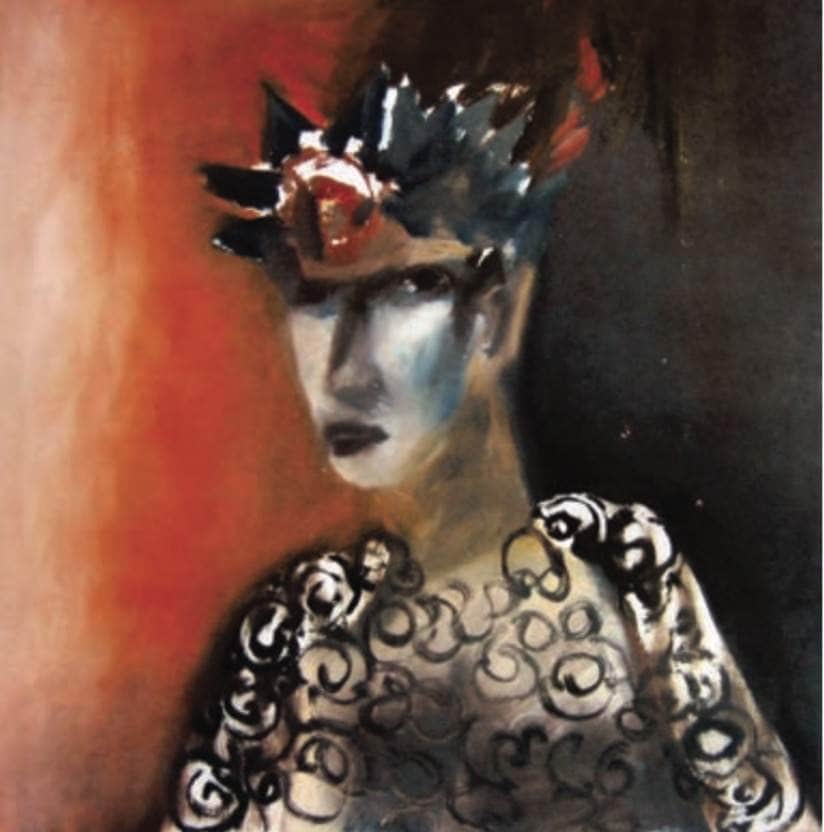
121 x 121cm, oil on composition board, signed and dated ‘28/4/64’ on the reverse.
Exhibited
- ‘Sidney Nolan: A Retrospective Celebrating his 75th Birthday’, Harewood Terrace Gallery, Leeds,19th Jul – 31st Oct 1992 no.25 or 26 ‘Head’ (see photograph p.71)
Provenance
- Sidney Nolan Estate
- Private collection Sydney
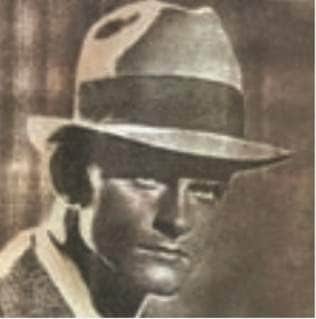
A certain look
Sidney worked at Fayrefield Hats between 1933-38 creating “displays to go into shop windows.”7 The influence of Fayrefield advertising (above) is immediately recognisable in ‘Woman with spiked hat’.
07 Woman (pink flower hat)
121 x 121cm, oil on board, signed and dated ‘Nolan 29-4-64’ lower left.
Exhibited
- ‘Sidney Nolan: A Poetic Vision’, Queensland University of Technology, Brisbane Australia, 5th Jun – 17th Aug 2008
Literature
- Andrew Turley, Painted Ladies, Portrait, Magazine of the NPGA, Spring (Sep) 2015, p.65 illus (col)
Provenance
- Waddington Galleries
- Lord MacAlpine of West Green Collection
- Douglas Kagi Collection
- Mossgreen Auctions, Important Australian & International Art, Melbourne, 24/06/2014, Lot 27
- Private collection from 2014
08 Portrait of a lady
121 x 121cm, oil on hardboard
Exhibited
- Sidney Nolan: Paintings, Drawings and Theatre Design’, Grosvenor Museum, Chester, 22 Jul – 18 Sep 1983‘
- Sir Sidney Nolan: Seven Portraits 1964’, An exhibition in honour of Australia’s Bicentenary, 1st to 30th Jun 1988, Tambaran Gallery, 20 East 76 Street, New York no.7
Literature
- ‘Sidney Nolan: Paintings, Drawings and Theatre Design’, Grosvenor Museum, Chester, 22 Jul – 18 Sep 1983 no.34 (illus) incorrectly dated1969
- ‘Sir Sidney Nolan: Seven Portraits 1964’ catalogue, 1st to 30th Jun 1988, Tambaran Gallery, New York (illus)
Provenance
- Current location unknown
Bold shadows across the eyes of ‘Portrait of a lady’ suggest that she dates with the only other two works bearing the same feature: ‘Woman with spiked hat’ (no.6) and ‘Woman pink flower hat’ (no.7) whose detail is shown below.
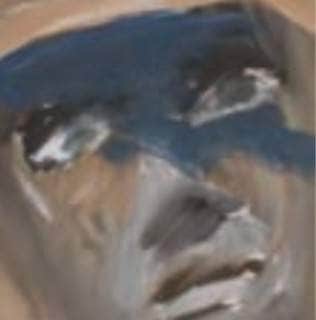
Eye shadow
09 Girl (and the moon)
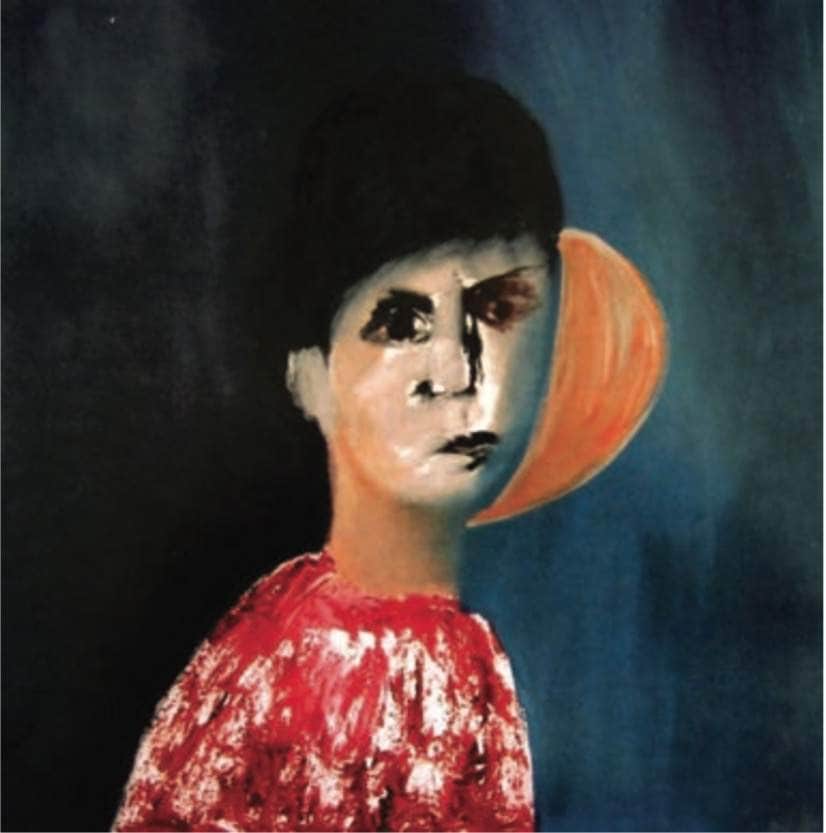
122 x 122cm, oil on composition board, signed and dated ‘29.4.64’ lower left.
Provenance
- Sidney Nolan Estate
- Private collection
Sidney was well known for repeating formally satisfying motifs and ‘Girl and the moon’ is the first image of the series to draw thematically from his own work (also see Ned Kelly on p.128-131). ‘Boy and the moon’ painted in 1939-40 was an abstract work Sidney described as looking “like a human being with a neck on it”. Surrounded by controversy, the highly original image helped to establish his career and he repeated it several times – on the roof of Heide in 1942 (where Air Force Intelligence thought he was signalling Japanese bombers), in 1962 when he painted it 10m wide as a backdrop for Covent Garden’s production of ‘The Rite of Spring,’8 and here among the Adelaide Ladies, where the face and the crescent moon combine to create the same abstract shape.
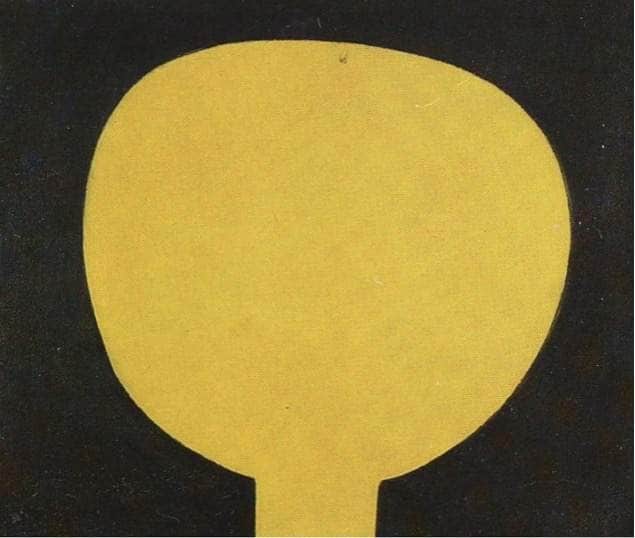
Sidney Nolan, “Moonboy” or “Boy and Moon”, 1939-1940, collection NGA. Hidden icon. Sidney’s ‘formally satisfying’ shape of ‘Boy and the moon’ (above) reappears almost 25 years later in female form among the Ladies (right)
10 Woman (with frill)
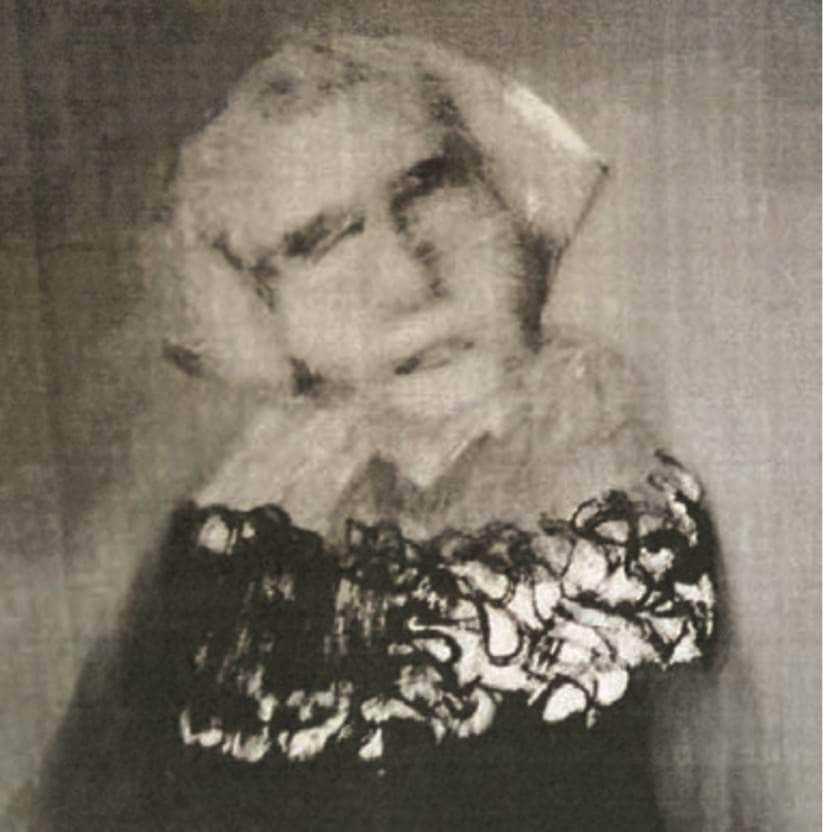
121 x 121cm, oil on hardboard.
Exhibited
- ‘Sir Sidney Nolan: Seven Portraits 1964’, An exhibition in honour of Australia’s Bicentenary, 1st to 30th Jun 1988, Tambaran Gallery, 20 East 76 Street, New York no.4
Literature
- ‘Sir Sidney Nolan: Seven Portraits 1964’ catalogue,1st to 30th Jun 1988, Tambaran Gallery, New York (illus)
Provenance
- Current location unknown
Woman with frill’ is the first of seven works that were exhibited in New York during Australia’s 1988 Bicentenary. All were undated but she fits best within the 29th April to 6th May window. The looping brush strokes in the frill are reminiscent of the patterns from April 28th and 29th. Conversely, her hat is missing and the shadowy face is a closer reflection of works from 1st and 5th of May.
11 Woman (rose hat)
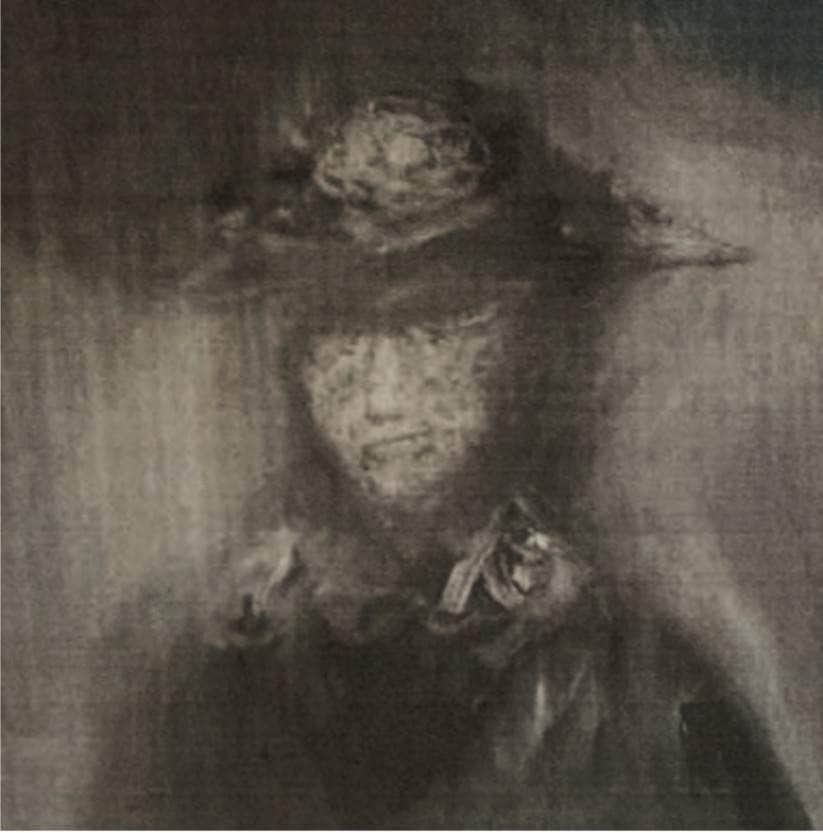
121 x 121cm, oil on hardboard.
Exhibited
- ‘Sir Sidney Nolan: Seven Portraits 1964’, An exhibition in honour of Australia’s Bicentenary, 1st to 30th Jun 1988, Tambaran Gallery, 20 East 76 Street, New York no.3
Literature
- ‘Sir Sidney Nolan: Seven Portraits 1964’ catalogue,1st to 30th Jun 1988, Tambaran Gallery, New York (illus)
Provenance
- Current location unknown
It is extremely difficult to date ‘Woman rose hat’ (right) because shadowy second-hand black and white images are the only reference. Based on the style of the bloom in the centre of her hat, it is possible she was painted around the same time as ‘Head untitled’ (no.59) in early June. But the facial features (without highlighting or over-strokes) lean toward the last days of April or first week of May.
12 Head (untitled)
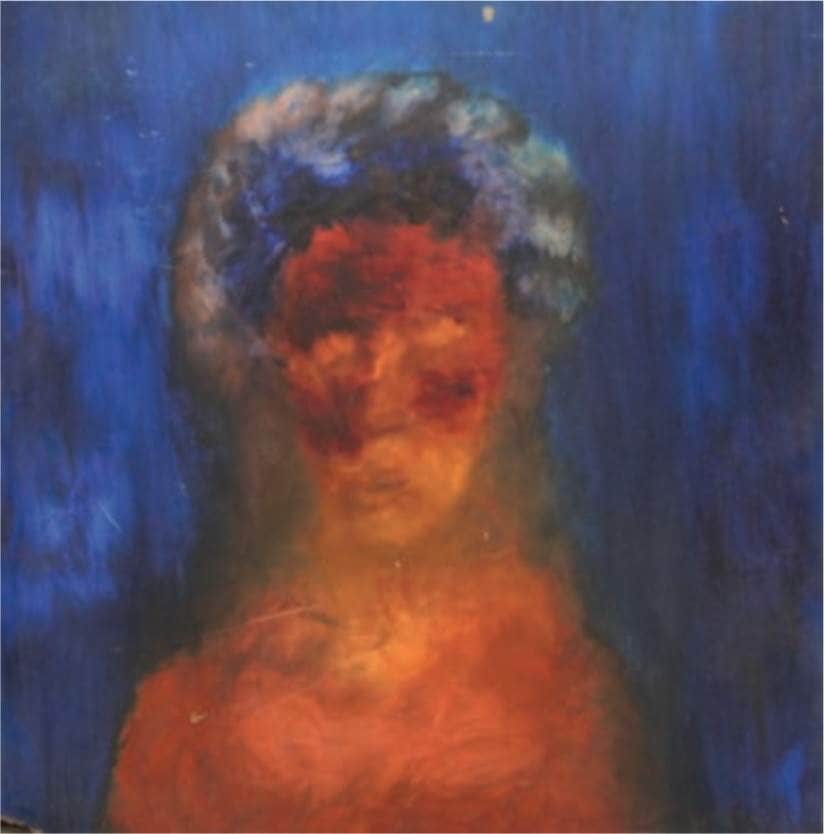
121 x 121cm, oil on board, signed and dated on reverse ‘E25938 / 1-5-64 / Nolan / 35’.
Provenance
- Sidney Nolan Estate
- Private collection
13 Woman (princess)

121 x 121cm, oil on board, signed and dated lower right corner in white paint ‘Nolan / 5-5-64’.
Exhibited
- ‘Sidney Nolan: Ern Malley and Paradise Garden’, Adelaide Festival Exhibition, The Art Gallery of South Australia 1974
- ‘Adelaide’s Nolans’ The Art Gallery of South Australia 1983
- ‘Sidney Nolan: the city and the plain’ National Gallery of Victoria, Melbourne, VIC, Oct – Nov 1983 no.64 ‘Princess’
Provenance
- Sidney Nolan collection to 1974
- Art Gallery of South Australia from 1974
On May 5th hands replaced hats for a day. This painting and ‘Head untitled’ (no.14) on the following page are something of an anomaly – a twist in style with arms raised, hands on head, a lightness of image and distinct lack of fashion accessories unusual at this stage in Sidney’s series. The image is strikingly similar to photographs taken of Sunday Reed at Heide in the 1940s but a third work partially dated the same day – ‘Woman with red hair’ (no.15) – quickly twists right back into character.
The painting’s second title ‘Princess’ used by the Art Gallery of South Australia was a 1974 addition by Sidney. See ‘Woman / Princess in hat’ on p.160.
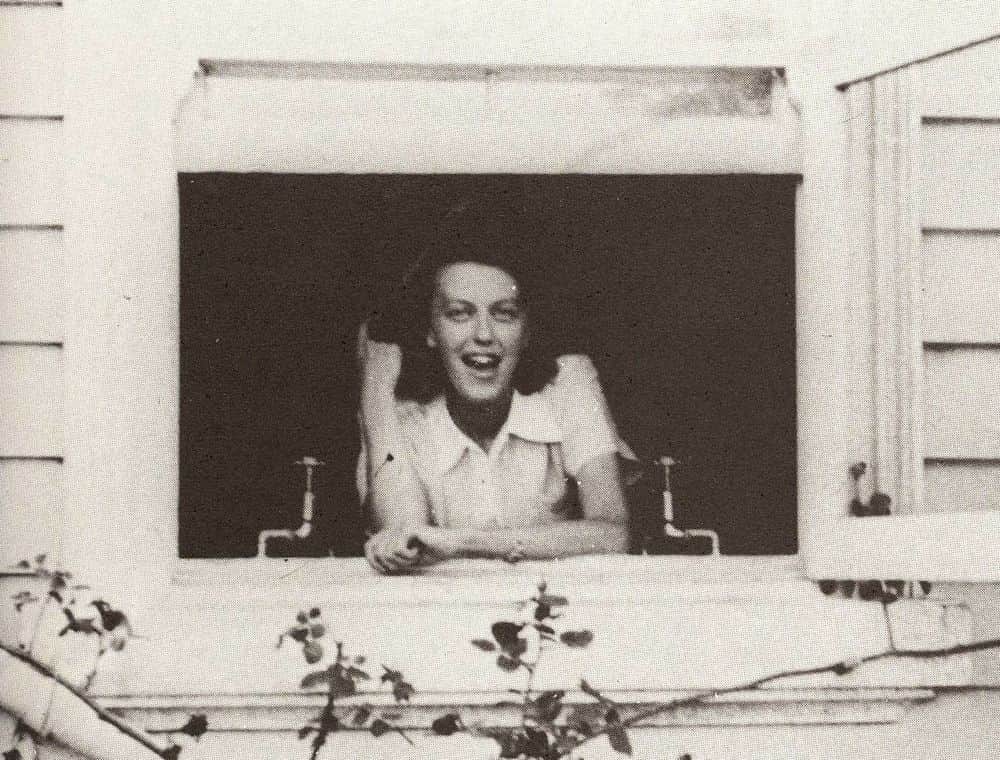
Sunday Reed at Heide. Sunday Reed was painted into the Adelaide Ladies on 23rd and 24th of May. This much earlier painting also bears a striking resemblance to Sunday in this photograph from Heide
14 Head (untitled)

121 x 121cm, oil on board, signed and dated on reverse ‘Nolan 5.5.64’.
Provenance
- Sidney Nolan Estate
- Private collection
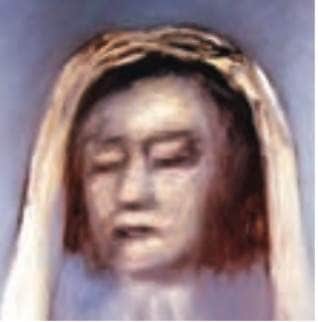
Finishing School.
The care and attention paid to the face of ‘Woman hands on head’ (above) suggests that ‘Head untitled’ may be Sidney’s first work leading to the more refined expression in no.13.
15 Woman (red hat)
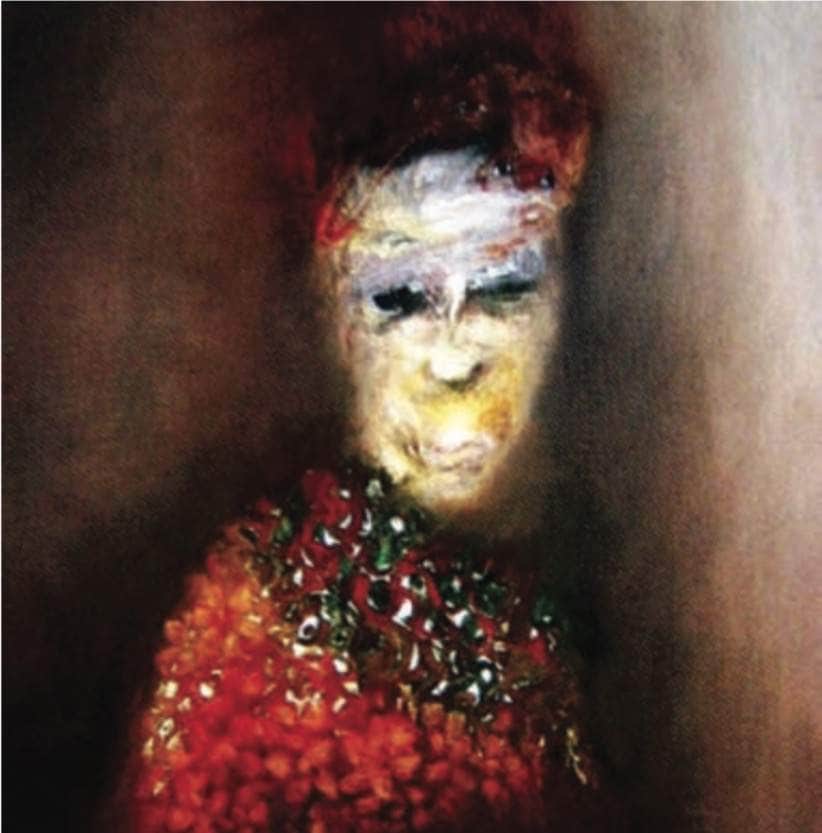
121 x 121cm, oil on board, signed and dated ‘6.5.64’ lower right, signed and dated ‘5.5.64’ on the reverse.
Exhibited
- Institute of Contemporary Arts, London, Poetry International Festival, 19-24 Jun 1972
Provenance
- Cynthia Nolan Collection to 1976
- Charles Osborne Collection London to 1993
- Private collection
‘Woman red hat’ and ‘Woman white flowers’ (no.16) over the page, were two of the eight Ladies that appeared at the Institute of Contemporary Arts in London as part of the 1972 Poetry International Festival. Extracts from ‘Paradise Garden’, Sidney’s recently published poems, were read by Edward Woodward and Vivienne Merchant as the Ladies looked on with what could only be considered stern expressions.
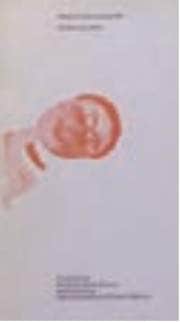
Narcissus. Humorously, Sidney’s Narcissus, from ‘Narcissus and Waterfall’, graced the Poetry International 1972 programme cover where his verse was read and his Adelaide Ladies held court
16 Woman (white flowers)
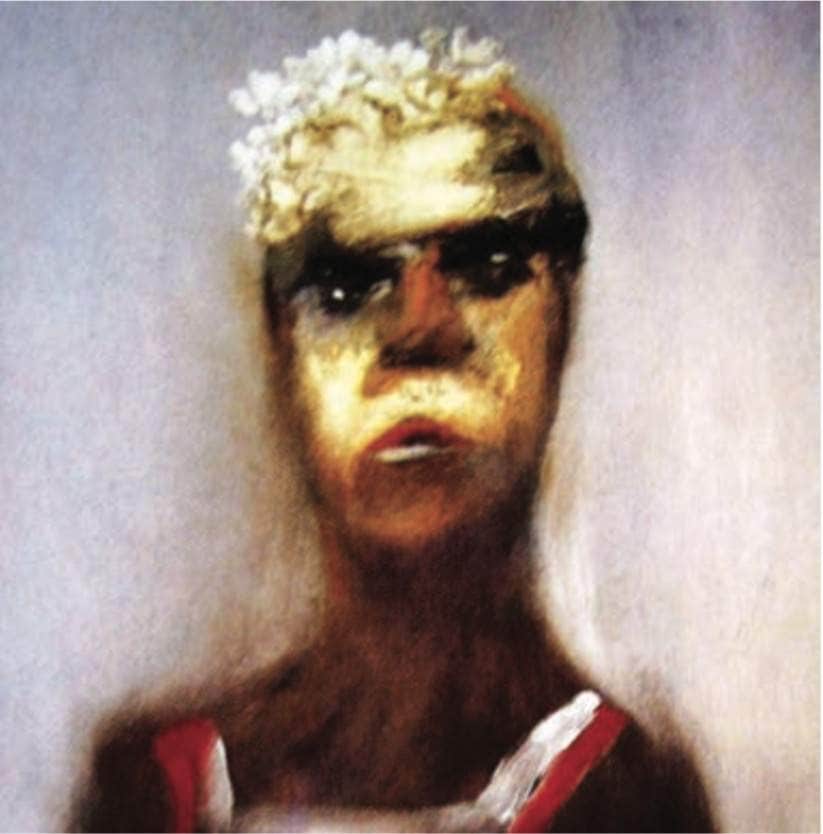
121 x 121cm, oil on board, dated lower right ‘6.5.64’.
Exhibited
- Institute of Contemporary Arts, London, Poetry International Festival, 19-24 Jun 1972
Provenance
- Cynthia Nolan Collection to 1976
- Charles Osborne Collection London to 1993
- Private collection

European eyes.
Sidney had an extremely strong connection with indigenous Australians. It is possible these two unusual portraits reflect his concerns over Aboriginal identity and “European eyes and demands” that “as far as we could see were frightened of these things”9
17 Woman (laughing)
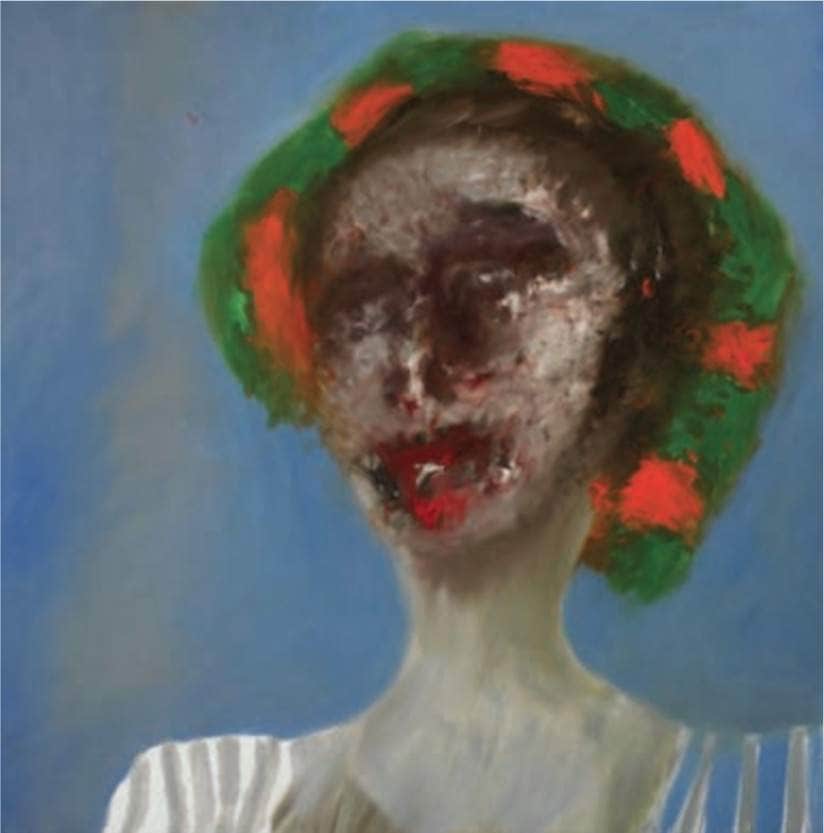
121 x 121cm, oil on board, signed and dated ‘12.5.64 / Nolan’ lower centre.
Notes
- JH on reverse are possibly the initials of Sidney Nolan’s studio assistant, John Hull
- ‘S759’ on reverse is also on the reverse of ‘Woman hand on hat’ (no.5) and ‘Country Woman’ (no.43)
Provenance
- Sidney Nolan Estate
- Private collection
‘Woman laughing’ is almost certainly a bridge between the social commentary of Group 1 and the creation of Group 2 in the style of ‘old masters’. Her distinct orange and green hat, bright red lips and disappearing face mature and evolve in ‘Woman orange and green’ (no.18). Once opened, the tins of orange and green paint soak through Group 2 in faces, backgrounds, or both.
IMAGE CREDITS
All images of Sidney Nolan paintings are © The Sidney Nolan Trust / Bridgeman Art Gallery.
Prime Minister Robert Menzies opening the Adelaide Festival 1964. Image source ABC ‘Talks Critics 3’, segment Ref PSG4038, transmitted 17 March 1964.
Melbourne, Mary Nolan and Sidney Nolan with ‘Woman orange and green’ 1st June,1987 photographed Michael Potter. Image courtesy Newspix. © News Ltd.
Sidney Nolan’s 75th Birthday Retrospective at the Terrace Gallery, Harewood House, Leeds 1992 © Harewood House Terrace Gallery.
PUBLICATION
© Andrew Turley 2016. All rights reserved. This document is copyright.
Except as permitted under the Copyright Act 1968, no part of this
publication may be reproduced without permission in writing from the
author. Neither may documentation be stored electronically in any form or
by any means, without the prior written permission of the author.
This document has been created solely for the purpose of promoting and
facilitating education and research.
Author: Andrew Turley
Editing: Harriet Richert
Book design: Savit Pookapun
The moral right of the author has been asserted.
Sidney Nolan images are © The Sidney Nolan Trust / Bridgeman Art Gallery.
For all other copyright and image acknowledgements see Copyright and
Credits above.
ISBN 978-0-646-59749-2
END NOTES
-
WT Art Exhibition Reviews, ‘Nolan Paintings at David Jones’, Sydney Morning Herald 5th May 1965 p.14.
- David Marr, ‘Patrick White Letters’ Random House Australia, 1994 p.259 – Patrick White letter to Ben Heubsch dated 12th June 1964.
- 1969 interview on BBC1 extract ‘Nolan on Nolan: Sidney Nolan in his own words’, edited Nancy Underhill, Viking, Australia, 2007 p.310.
- Marr Op.cit p.168 – Patrick White letter to Geoffrey Dutton 19/9/60.
- Brian Adams, Such is Life, Hutchinson, Melbourne, 1987 p.156.
-
Ibid p.156.
- Underhill Op.cit p.335.
- Ibid p.252 – Extracts from Sidney Nolan interviews with Bernard Smith April 1962 and Elwyn Lynn papers 21/4/1978.
- Catalogue for Indigenous Connections, Sidney Nolan’s ‘Rite of Spring’, Photographs by Axel Poignant, AGNSW 2nd Nov 2007 – 3rd Feb 2008. Natalie Wilson and Roslyn Poignant in conversation.
↩


